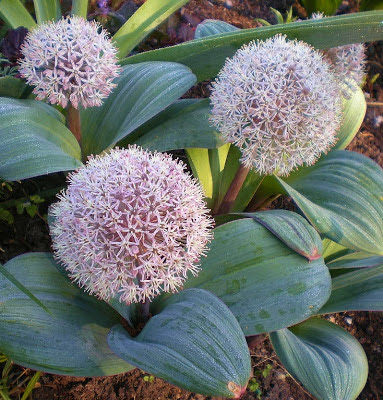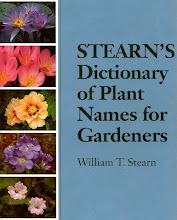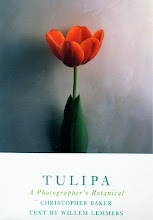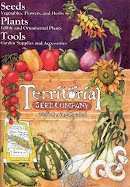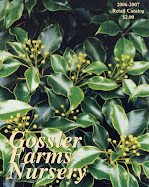
The border at the front of the house at Heronswood. May 2013

The pond near the house. May 2013

The kitchen garden, or
potager. This is an excellent use of the formal style to contain vegetables & give structure to a kitchen garden. In gardens such as this, there are echoes of baroque France.

This is a folly in the woodland garden. The structure, which is part fountain & part Greek temple with a definite air of ruination, was built in a style popular in gardens during the late 1980s & early 1990s in the Seattle area. It falls into the category of postmodern architecture. If it remains, I'm sure it will be interesting from a historical perspective.
 Hosta
Hosta & Ferns. May 2013
 Kniphofia northiae
Kniphofia northiae, one of the uncommon plants to be found at Heronswood. May 2013

Thanks to Max P. for identifying this as Symphytum x uplandicum 'Axminster Gold' There are no plant tags at Heronswood.
Heronswood is quite a famous place among plant enthusiasts in the Seattle area & known around the world by horticulturalists familiar with the botanical collections of Dan Hinkley, who established the gardens & a nursery with his partner Robert Jones on 15 acres on the
Kitsap Peninsula outside of Kingston, WA in 1987. They lived in a house on the property. The gardens have been featured
internationally as an example of creative, environmentally sensitive & botanically impressive garden design.
The garden & nursery business were bought by the
W. Atlee Burpee Company for close to $4.5 million in 2000. Burpee closed the garden in 2006 & moved many of the nursery plants to sites on the east coast. The Heronswood botanical garden and Heronswood Nursery Company was
sold to the
Port Gamble S’Klallam Tribe in 2012. Burpee originally asked $11 million for the property. The tribe bought it for less than $1 million.
In 2001, Valerie Easton wrote for the Seattle Times: Last summer, gardeners gasped over the sale of homegrown Heronswood to
W. Atlee Burpee. It seemed an unlikely union. Heronswood has a worldwide
reputation for being first with "gotta-have-it" plants, while Burpee's
image is as stodgy as the familiar annuals and vegetable seed it has
offered for 125 years. But why would Heronswood, with all its success and even adulation, join
forces with Burpee? Hinkley says they weren't looking to sell, but
explains, "Robert and I were drowning in the responsibilities of this
thing we had created . . . there was no down time."
Hinkley and Jones plan to make good use of that newfound time. They'll
continue to manage the nursery. Jones, an architect, is designing a new
house, where they look forward to having a smaller, private garden.
Hinkley is scheduled to give 57 talks in several countries this year,
hopes to finish the three books he is writing, and plans to devote more
time to expeditions. He'll journey twice to Europe and Japan this spring
and then to Nepal or southeast Tibet in the autumn, bringing back yet
more plants to excite us.
In 2006, Anne Raver wrote for the New York Times: On May 30, the Heronswood Nursery gardens in Kingston, Wash., the
horticultural paradise that Daniel J. Hinkley and Robert Jones started
19 years ago with a single truckload of rare plants — which eventually
grew into a collection that would change the face of American gardening —
were closed by W. Atlee Burpee & Company, the nursery's corporate
owner. Mr. Hinkley said in a telephone interview that George Ball, Burpee's
C.E.O., and three of his staff members came that day from Burpee's
Pennsylvania properties to dismiss Mr. Hinkley and most of the nursery's
24 employees.
Mr. Hinkley said that
there had been early signs of trouble after Burpee bought Heronswood
six years ago, but that the nursery had continued to operate pretty much
as it had. Still, he said, he and Mr. Jones spent "six years waiting
for the crash you know is coming." Mr. Ball said the move is a
business matter. "We are moving the nursery, not closing it, because it
was losing money," he said by phone on Saturday from Fordhook Farm, the
Burpee homestead and testing grounds, in Doylestown, Pa., where 1,000
of Heronswood's 6,000 plants had been moved over the past few years.
Thousands of others will be moved to a 50-acre site in Willow Hill, Pa.,
and a 30-acre site in Selbyville, Del.
Thomas C. Cooper, the
former longtime editor of Horticulture magazine, who has known Mr.
Hinkley and Mr. Jones for years, said he sees Burpee's decision as a
mistake. "This is not a brand like Tide, where you can swap out C.E.O.'s
and move corporate headquarters and the brand goes on," he said. "There
is no Heronswood without Dan and Robert." The Heronswood catalog, a 250-page list
of thousands of plants with cliffhanging reports of Mr. Hinkley's
latest plant-collecting adventures in the Himalayas or South America,
had a huge cult following.
"It
wasn't a profitable business when we bought it," Mr. Ball said. (Mr.
Hinkley said he and Mr. Jones made a decent living from Heronswood, but
acknowledged that at times they had to subsidize it from their own
pockets to make winter payrolls.) "But I bought it for the
plants," Mr. Ball continued, "to get rare and unusual plants into
mainstream gardening," with the idea that this strategy would eventually
pay off. Within six
months of the Heronswood sale in 2000, Mr. Hinkley said, "the
expectations changed."
Business was so bad, Mr. Ball said, that in 2003, he asked the former owners to buy Heronswood back for $2 million. At that point, Mr. Hinkley said, he and Mr. Jones could not afford even that price. Mr. Ball said Heronswood's gardens — 5½ acres of the
garden, as distinct from the business Burpee is moving — will not be
depleted even as the best specimens are taken for propagation and
testing. "I would like to find some kind of buyer who would keep it open
to the public," Mr. Ball said. He pictures a "high-end retirement
community, with nice condos" built around the gardens on the 15-acre
Heronswood property.
According to
Heronswood.com, maintained by the Port Gamble S'Klallam Tribe, the property was purchased during the
summer of 2012. Since then, volunteers have worked to restore
the garden under the direction of Dan Hinkley. The Port Gamble S'Klallam
Foundation is responsible for ensuring that the garden's integrity is
maintained while managing community events & activities, such as
plant sales, open garden days & other fundraising
efforts to benefit the gardens. The garden had been closed to the public since
2006. The situation seemed sad and hopeless until the
Port Gamble S'Klallam Tribe took ownership of the property and they quickly moved
forward with plans to restore this botanical treasure. The Port Gamble S'Klallam Reservation is located not far from Heronswood.
Heronswood opened to the public for the 1st time in 7 years on May 18, 2013. As you might expect, the gardens don't look as nice as they once did. I haven't been there since before it was sold in 2000. But the place was not a disappointment. One would hope to see steady improvement in the future.













